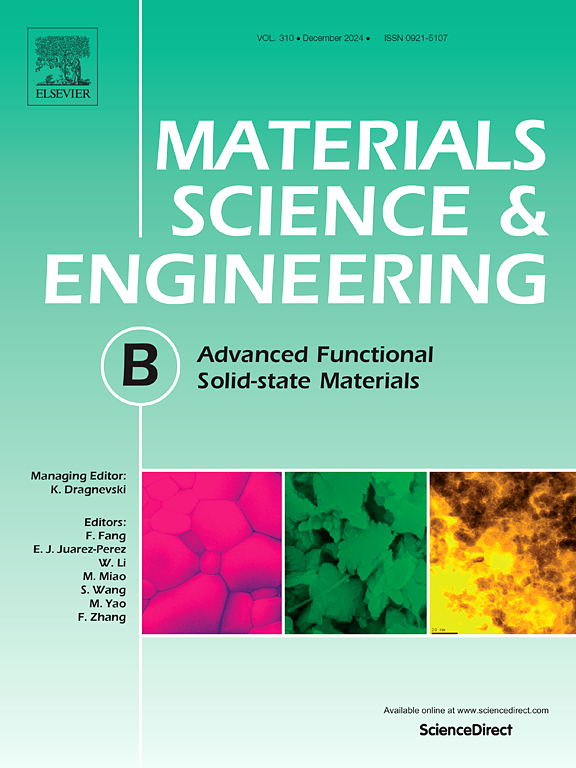两负成正:共掺杂对新型质子陶瓷燃料电池电解质srsn0.8 sc0.3 2o3−δ低温电性能的影响
IF 4.6
3区 材料科学
Q2 MATERIALS SCIENCE, MULTIDISCIPLINARY
引用次数: 0
摘要
质子陶瓷燃料电池(pcfc)在开发同时具有高质子导电性和低温烧结性的电解质方面面临着重大挑战。虽然SrSn0.8Sc0.2O3−δ (SSS)由于其优异的热化学稳定性而成为传统BaZrO3-和baceo3 -基体系的有希望的替代品,但其导电性仍然不足以用于实际的低温(<500°C)应用。在本研究中,在单掺杂失败的情况下,我们通过Ba和Yb的掺入制定了合理的共掺杂策略,以同时提高SSS电解质的体电导率并降低晶界电阻。优化后的组合物Sr0.95Ba0.05Sn0.8Sc0.15Yb0.05O3−δ在400℃时电导率提高26.3%,晶界电阻降低71.7%。单电池测试证明了实际的好处,因为与未掺杂的电解质相比,共掺杂电解质在500°C时的功率密度增加了38.7%。这些发现为通过控制共掺杂改进质子导电电解质的发展提供了有价值的见解,并为优化低温pcfc中基于sss的材料提供了一条有前途的途径。本文章由计算机程序翻译,如有差异,请以英文原文为准。

Two negatives make a positive: Benefits of co-doping on electrical property of new protonic ceramic fuel cell electrolyte SrSn0.8Sc0.2O3−δ at low temperatures
Proton ceramic fuel cells (PCFCs) face significant challenges in developing electrolytes that simultaneously exhibit high proton conductivity and good sinterability at reduced temperatures. While SrSn0.8Sc0.2O3−δ (SSS) has emerged as a promising alternative to traditional BaZrO3- and BaCeO3-based systems due to its superior thermochemical stability, its conductivity remains insufficient for practical low-temperature (<500 °C) applications. In this study, where single doping fails, we develop a rational co-doping strategy through the incorporation of both Ba and Yb to simultaneously enhance bulk conductivity and reduce grain boundary resistance in SSS electrolytes. The optimized composition, Sr0.95Ba0.05Sn0.8Sc0.15Yb0.05O3−δ, shows a 26.3 % increase in conductivity and a 71.7 % reduction in grain boundary resistance at 400 °C, due to synergistic phase modification and defect optimization. Single-cell tests demonstrate practical benefits, as the co-doped electrolyte delivering a 38.7 % increase in power density at 500 °C compared to its undoped counterpart. These findings contribute valuable insights into the development of improved proton-conducting electrolytes through controlled co-doping, and suggest a promising avenue for optimizing SSS-based materials in low-temperature PCFCs.
求助全文
通过发布文献求助,成功后即可免费获取论文全文。
去求助
来源期刊

Materials Science and Engineering: B
工程技术-材料科学:综合
CiteScore
5.60
自引率
2.80%
发文量
481
审稿时长
3.5 months
期刊介绍:
The journal provides an international medium for the publication of theoretical and experimental studies and reviews related to the electronic, electrochemical, ionic, magnetic, optical, and biosensing properties of solid state materials in bulk, thin film and particulate forms. Papers dealing with synthesis, processing, characterization, structure, physical properties and computational aspects of nano-crystalline, crystalline, amorphous and glassy forms of ceramics, semiconductors, layered insertion compounds, low-dimensional compounds and systems, fast-ion conductors, polymers and dielectrics are viewed as suitable for publication. Articles focused on nano-structured aspects of these advanced solid-state materials will also be considered suitable.
 求助内容:
求助内容: 应助结果提醒方式:
应助结果提醒方式:


